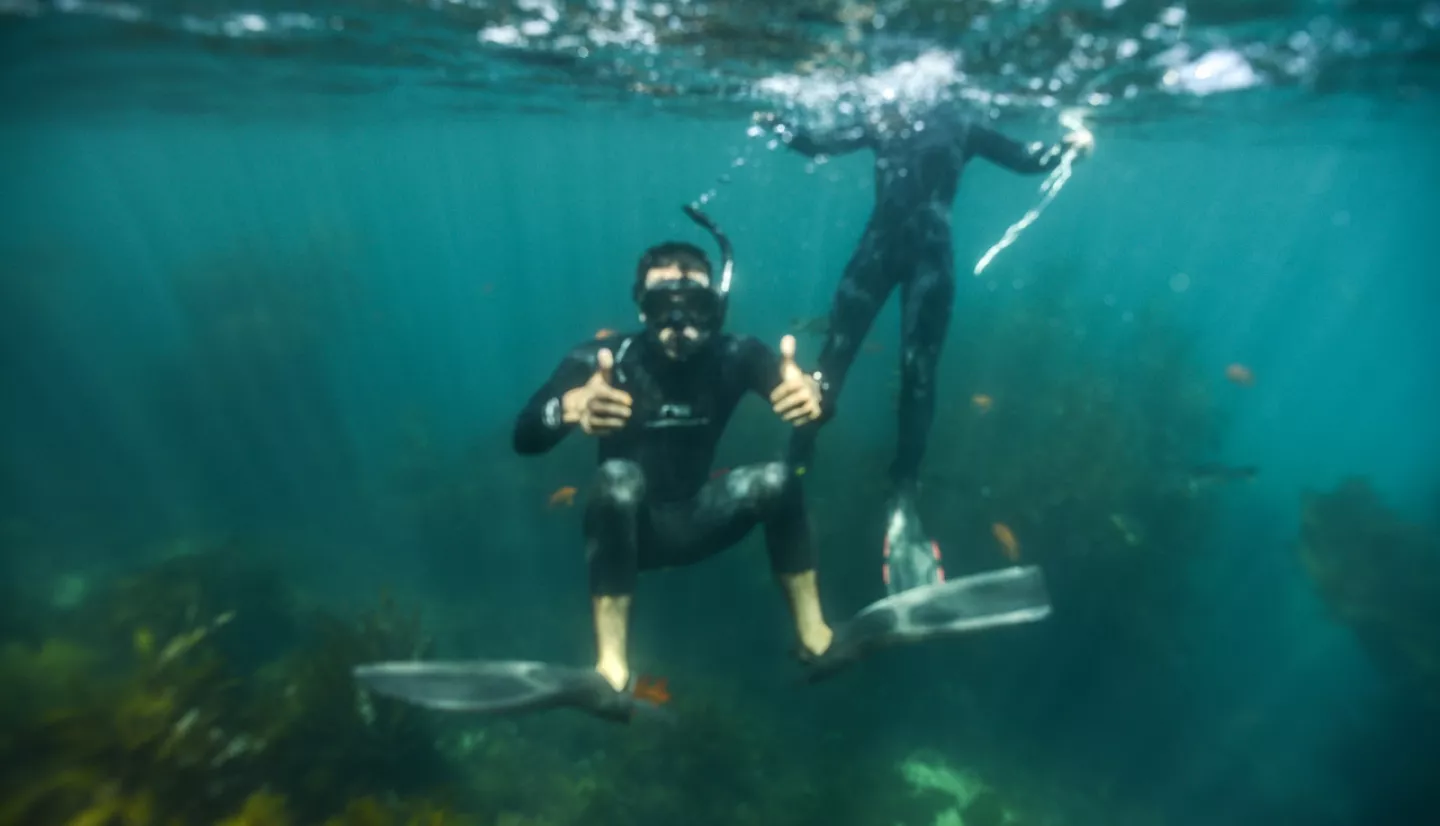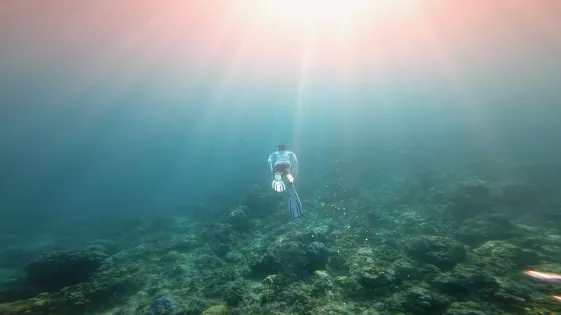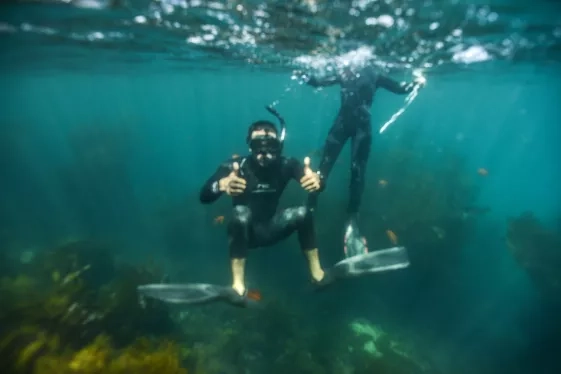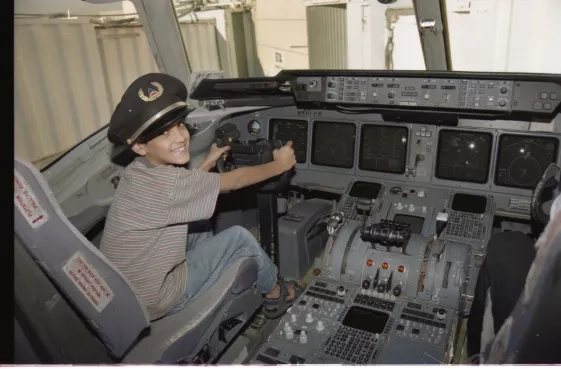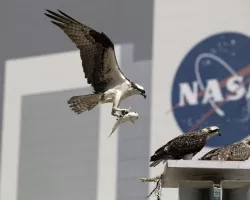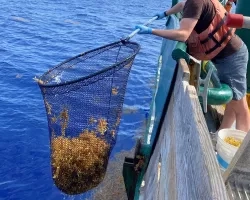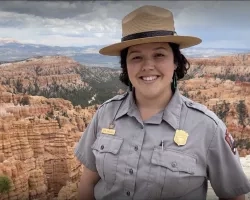When Ved Chirayath says he has the dream job, it’s hard to disagree. He’s turned his lifelong passion for NASA and space exploration into a career developing technologies and instruments that help us better explore something closer to home—Earth.
Chirayath is the Vetlesen Professor of Earth Sciences, Aeronautics, and Mechanical Engineering at the University of Miami; director of the Aircraft Center for Earth Studies (ACES), and a National Geographic Explorer. He’s worked with NASA for over a decade and was even one of the 30 finalists for the NASA Astronaut Candidate Class of 2021.
Listen below to learn how Chirayath’s endless curiosity and passion for astrophysics helps him create innovative solutions to remote sensing challenges. And how he works with NASA Earth on projects that help us better explore our oceans, learn to see the ocean more like the creatures who live in it do, and inform ecological conservation work around the world.
The transcription below has been edited for readability and clarity.
What are you working on with NASA?
Oh, I have kind of the dream job. I had worked at NASA for 10 years. And I have basically the same job here now with a lot of the same NASA grants and projects.
One thing I'm really excited about actually brought with me is Oceans Across the Solar System. This is a new initiative that's trying to merge a lot of the knowledge that there is at NASA from planetary science, the search for life beyond Earth, and our knowledge of Earth systems and the oceans, and basically the only example of life we have in the universe.
I'm really passionate and excited about exploring our home world to try to better understand and inform the search for life elsewhere. And in that process I've become—I went from being an astrophysicist and a theoretical physicist to an oceanographer, and I primarily develop new technologies and instruments for NASA, NOAA, and other places to study the ocean floor, to map it, to essentially fill in the gaps and knowledge we have. Which for the ocean, it's quite startling from astrophysics.
One of the reasons why I moved into oceanography is that we've mapped more of the surface of Mars and the moon, and even the sun than we have of our own ocean floor.
One of the projects I'm leading is a global effort to automate the coral reef detection of organisms and change over time. So just like we study on Earth's land—you know, how crops are changing over time or how forest areas are changing—we don't have any of that kind of knowledge in the water just because there's no baseline mapping data.
So a lot of times we'll go to an island. We'll map an entire coral reef. And then we'll return every year and do that again and again, so that they can look at what's changing in the environment and sort of come up with a census for that coral. And then they say, “Okay, you know, this one's doing well, it's recovering.” Or, this one got hit by a marine heat wave. We need to reduce some pressures on it to help it recover itself.
That model works very well, except it's sort of based on this parachute science model. Someone will come out, they bring these technologies, they do the science, and then they share the results of the community.
But in all of the best kinds of science conservationist engagement that we've seen, the long-lasting efforts involved the local community at a grass roots level.
So what we're trying to do right now is launch a global four-year effort to–and we've done this in Guam successfully with another NASA Grant. In Guam we trained 25 local pilots. These are students who'd never flown a drone before. We give them advanced drones. We flew them like sensors and said, “Okay, we're going to train you and pay you every year to go and map your own reef and preserve it.”
And the minute that you get local folks involved in their own conservation, then they see for themselves. This is what the reef looks like. This is the reef that they depend on. They're invested in protecting it, and they produce the data sets themselves. They have sovereignty and ownership over it.
It completely changes the paradigm from this parachute science model to a capacity building, you know, indigenous community model where we are sharing that knowledge. And they're sharing the data with us.
Has being an astrophysicist made you a better oceanographer? Has oceanography made you a better astrophysicist?
Actually, they're very similar in that both of them are working in an environment that's hostile. It's not a great place to be. Cold on top of a mountain, if you're an astronomer, or seasick in the middle of the Pacific if you're an oceanographer.
What I deal with a lot is remote sensing, so trying to study these environments without touching them from afar. Astronomers are very good at not touching things, mostly because they can't, so they get all the information they can from light, right? And light has so much information in it. Just from this image you can tell I'm human, there's a chair. There's materials, there's colors or spectra that tell you information about what I am and what this is.
We use that same information with telescopes to look out the universe. With satellites and aircraft we can look down at Earth and try to assess the same information, but the challenge is always in water. It's dark, right? It gets really dark, really quickly, and that for a lot of oceanographers is the end of the story.
For me it was like, well in astronomy all you work with are things that are dark. You're working in this limit of tiny amounts of light, and astronomers are not shy about building very large space telescopes to solve the problems of this darkness, to try to gather as much light as they can to detect something and pull it out from nowhere.
And I think, as oceanographers, we should adopt that same philosophy.
We're looking at the ocean like humans do. And we need to be looking at the ocean like animals in the ocean do with massive eyes.
Big optics, things that can see very, very deep in the water. Because it's there to be gleaned, it's just a matter of will. Just like astronomers dreamed up the James Webb Space Telescope, and the OWL was my favorite (the overwhelmingly large telescope). All of those telescopes started as: this is what this is what the physics is saying we should do.
And in oceanography I've made a career of saying, “Well, the physics demand this, and so I'm going to invent an instrument that can do that.”
What experience do you think every person should have to change how they think about ecological conservation?
One example I like to share is the parrot fish. They’re very pretty looking, happens to also be very delicious. So people eat them a lot in the Caribbean. And a lot of the Caribbean coral reefs, as a result, have or are in a state of collapse.
In Bonaire they tested what would happen if we did not harvest parrotfish. So the fishermen were told, “Okay, you can go after different things. But let's try to let the parrotfish recover, to see if it has an effect on the coral reef.” And the entire coral reef ecosystem recovered because these guys were going around cleaning the coral from algae and helping it recover. And then, as a result, the fish stocks of everything else went up.
It’s an example of having a little bit of knowledge of how that interconnectedness works and then using it to say, “Okay, I'm going to create a conservation solution that doesn't change fundamental culture at this place, but allows the natural system to recover itself.”
I hope that that people—if they want to understand their world, and how animals live, they should go out and make animal friends, and try to understand and live in their environment and see it for themselves.
One of the other experiences I had on one of my field missions was, it was a couple of months long on American Samoa, very far out in the Pacific. Every day I was on the reef moving an instrument back and forth. And there was this little thing in the corner of my eye. I just kept feeling that it was there. And only the fourth week did the octopus finally let me see it. It was this little baby octopus that had been coming and looking at me at the same time I went out. And over the course of the next month it would come closer and closer, eventually, like touching the camera and the instruments I was using, trying to figure out, “Who are you? And what are you doing in my reef?”
It was just so inquisitive. And I think what's exciting about getting to be an oceanographer and somebody who—I just was honored to be one of 30 finalists for the Astronaut Corps—one of my main goals for being an astronaut was to try to understand: Can we find life elsewhere? You know? Can we understand what other worlds are to inform that search for life?
And here in the ocean you get to have this eye-to-eye look with another creature and see that it is sentient. And then realize that it's looking at you and asking the same question.
That's just, for me, the most mind-blowing experience. Getting to be in an environment where animals regularly look at you and recognize your sentience, and you get the opportunity to look back at them and see the same thing and realize. Oh, my gosh! This is really just one little planet, and we're all kind of getting along together, for better or for worse.
You’ve an innovator and an inventor in this space (FluidCam and MiDAR). What’s next with advanced sensing? What possibilities and innovations are you excited about?
NASA's been super supportive of encouraging my basically Star Trek ideas, trying to apply them to our sense of on Earth. So again, the ocean is dark, right? So that was my first challenge. And I spent my Ph. D. trying to develop a way that can see deeper in the column of water as well as see through ocean waves, which blur and refract what you're looking at.
That technology, fluid lensing, now works very well. And we've done it at global campaigns to map coral reefs. We find all kinds of things in those reefs. So if someone drops a cell phone or like a tire.
I mean, it's like you're mapping the planet for the first time and seeing down to 65 feet. There's more surface area of planet in that first 65 feet than there is land. Every time we look at new data sets, we're seeing new organisms, new coral structures, new marine debris.
We just did a campaign in Guam which got hit by the typhoon. The corals were protecting the island massively, and that became clear when we started looking at the corals and how much of the hurricane they took on.
The second technology I had invented at NASA—MiDAR—takes this to the next step. It adds active laser sources and light emitting diodes to basically shine a light deep down from aircraft or from spacecraft into the ocean to see deeper.
And what's really exciting, I think, is we're now at this precipice of understanding the ocean the way that animals that live in it do.
Most animals in the ocean they communicate again through bioluminescence to through color. Then there's also acoustics. We've been studying the ocean acoustically. What we're doing with MiDAR right now with a new NASA grant is mapping the ocean in the ultraviolet and the blue wavelengths.
So when you go down deep in the water, first it starts getting darker and darker. Then it starts getting very, very blue, because most of the longer wavelengths of like red and green are all scattered or absorbed.
When you get down to about 65 feet, 75 feet depth, it's basically only blue. And then there's all these colors in ultraviolet.
But humans are not designed to see them.
We can see blue a little bit, but really it just looks blue. We cannot see ultraviolet at all and ocean animals can.
So what MiDAR is capable of doing is revealing some of these ocean environments for the first time in ultra violet and blue. And we look at not just that one color. We look at 13 different colors in the ultraviolet and blue to get sort of the James Webb Space Telescope view of what the sea floor looks like.
It turns out that it is just wild. It's like looking at the ocean as if it were the Avatar film, Pandora, you know? We have these bioluminescent creatures and seas. That's what the ocean looks like to most sea creatures, and we're just for the first time seeing it the way they do.
And that means that when we look at coral now, it's not just a green or red or brown blob. It has these 13 different colors in the ultraviolet, and they're neon colored. And they've got, you know these striations and a lot of the diseases that they're facing, which are hard to detect, are easily visible in ultraviolet.
And so that's one of the main efforts I've been doing is trying to shift our attention from—we've been imaging the ocean like we've been imaging land. And on land, we're perfectly evolved, right? We evolved on land. So we see in colors that on land are omnipresent: red, green, blue.
In the water we're terrible. You go down deeper than 80 feet, and basically it's dark and we're blind. Fish can still see at those depths. So they're doing it because they're looking at the right colors.
That's one of the main things I'm very excited about is to see us looking at the ocean that same way. And then what that’s going to allow us to understand about the sea as a result.
What advice do you have for students, early career scientists, and anyone who's curious about Earth science?
Never, never lose that curiosity. I still feel like the 5-year-old kid coming to work and getting to see things for the first time. That never gets old.
Science is not easy. And, you know, being someone that was a lifetime Trekkie, and getting inspired by the discoveries they’re making, what they do not show you in Star Trek is that science is a lot of drudgery. Right? It's a lot of failing and spending tons of money and not getting a great result. And that's okay. You can get through these things if you can start learning how to build really good relationships with mentors and peers and learning from them, sharing in the failures when they happen. Finding, creating an emotional support group.
I think one of the nice things (there are a few) of being someone that identifies as LGBT is you learn to create—you know, in a lot of cases your family will cut you off and kind of disown you, or separate yourself. That support network that you grew up with is essentially pulled away from you. And so you're forced to create your own family, your own support network.
And a lot of scientists go through a similar process if you're challenging the status quo, where you're trying to think differently. Science is a very conservative field, and that can be very good. It's very methodical, but at the same time it can be brutal to try to adapt quickly. And it will shoot down sometimes very innovative ideas for fear that it might change the status quo or go against this order or method.
So I encourage a lot of people to remember that you've got to have grit, perseverance, a lot of charm and patience to get through something. Intelligence helps but some of the best scientists I've seen are folks that just do not give up.
You know, they're passionate, and they want to answer a question, and they pursue it, no matter.
I'm so lucky to have all along my career people that believe to me, that supported me, and a lot of allies that were not LGBT. I'm one of the only people in my field that identifies this way. And I'm certainly when I go to conferences generally the only person. I'm lucky that that's changing, but, you know, those are folks that recognize you're going through something difficult and are sticking their necks out to say, “Hey, I support you, even though I'm not part of this minority group.” And I had mentors at NASA throughout Academia in high school all of these different levels that were fundamentally instrumental role models in making me who I am today.
And then you get older, and you realize I now have to be this person to the next generation. I'm trying to do as much of that as I can, to tell people, “Look, you can do it. I've gone through this as well, but you'll have support, and people believe in you.”
